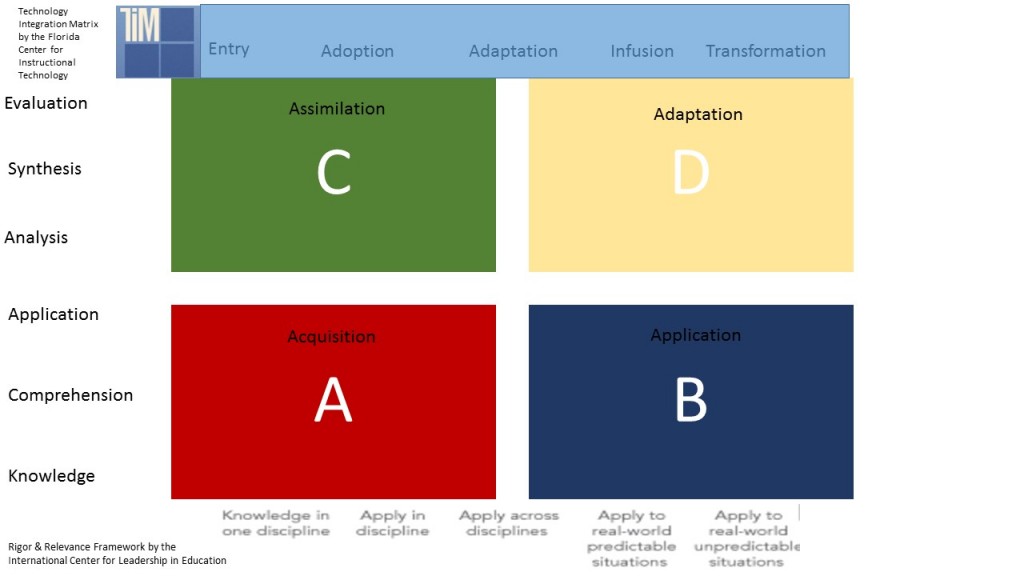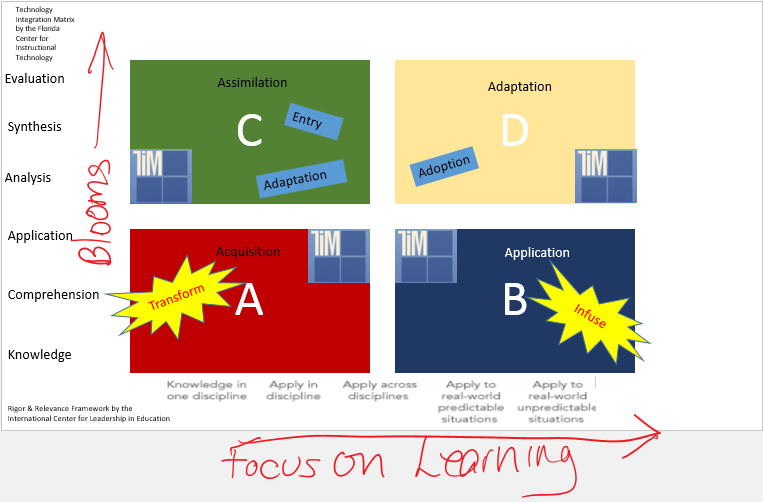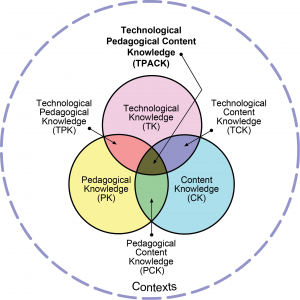Systematic Approach to Innovation for Learning

One of my primary job responsibilities is helping educators in my district to innovate by providing thought leadership and professional development to get us there. We have embraced University of South Florida’s Technology Integration Matrix (TIM) as a way to help teachers understand the different levels of technology integration, with an eye toward reaching transformation, all while understanding that not all teaching and learning will fall into this category. Much like with the Rigor and Relevance Framework created by the International Center for Leadership in Education, we recognize that learning brand new content often occurs in Quadrant A, or, on the TIM, in the “entry level.” We explain that we hope teachers can increase the frequency of teaching and learning that occurs in Quadrant D of the Rigor & Relevance Framework, or transformative teaching and learning in the TIM. But lately I’ve been wondering, will this get us to innovation? Or, will we have teachers that will be content with the low-hanging fruit – which would be Quadrants A & B, or Entry/Adoption?
The two models are different, in that the TIM focuses on levels of technology integration –the strategy for learning, rather than describing the learning. TIM is all about how the tools are being used – not on the results they produce. It is about inputs. The Rigor & Relevance Framework describes what the students are doing, and the outcome.

As I look at these models and reflect, I wonder if transformation, as described by TIM, is enough for innovation. (See http://d20innovation.d20blogs.org/files/2013/05/Technology-to-Learning-Design-Chart.jpg) For instance, if we are using technology in transformative ways, but it is only for acquisition or application of knowledge, or is limited to one discipline, can we even describe this as transformative, in terms of the impact on the learner?

Let’s face it, educational technology departments are stretched pretty thin, and so much of our efforts are still being spent on just trying to get more teachers to use technology. But to obtain the level of innovation that we seek, transformative learning that will prepare our students for an “unimagined future,” a systematic approach is needed, that meets teachers where they are, and consistently moves them forward in both pedagogical and technological knowledge, so that they can achieve the sweet spot described in the TPACK model –Technological, Pedagogical Content Knowledge. We can’t just focus on TIM, because that is only about inputs. To really achieve innovation, I believe we must also use the Rigor and Relevance Framework and backwards design process outlined in Understanding by Design, which includes setting learning goals for transfer.
Underlying truly meaningful and deeply skilled teaching with technology, TPACK is different from knowledge of all three concepts individually. Instead, TPACK is the basis of effective teaching with technology, requiring an understanding of the representation of concepts using technologies; pedagogical techniques that use technologies in constructive ways to teach content; knowledge of what makes concepts difficult or easy to learn and how technology can help redress some of the problems that students face; knowledge of students’ prior knowledge and theories of epistemology; and knowledge of how technologies can be used to build on existing knowledge to develop new epistemologies or strengthen old ones (Koehler & Mishra, 2009, accessed at http://tpack.org/tpck/index.php?title=Main_Page).
cross posted at Innovations in Education
Nancy White is the 21st Century Learning & Innovation Specialist for Academy School District 20, providing professional development on 21st century skills and technology integration, and working with the IT-ES team to carry out the district’s 21st Century Learning Plan. Nancy served on an ad-hoc team to help with the integration of 21st century skills into Colorado’s revised content standards, and co-authored The Colorado Learner’s Bill of Rights. Read more at Innovations in Education.
Tools and ideas to transform education. Sign up below.
